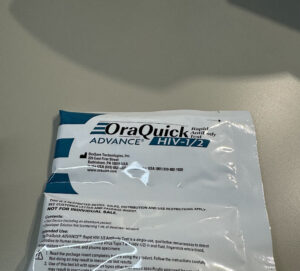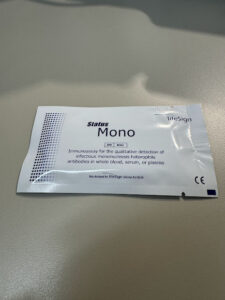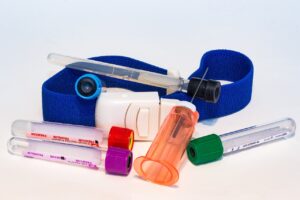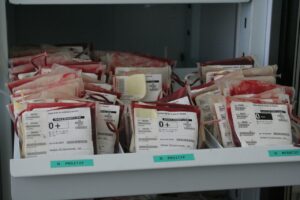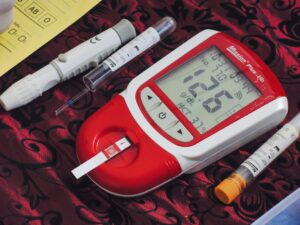
D-Dimer Background
D-Dimer is a protein fragment which is present in the blood when a clot is being actively dissolved. When there is a high concentration of D-Dimer present, the risk for thrombotic disorders goes up.
The D-Dimer lab test is useful in screening for clotting disorders like Pulmonary Embolism (PE), Deep Vein Thrombosis (DVT), Disseminated intravascular coagulation (DIC) and stroke. In conjunction with a medical history risk factor assessment, a negative D-Dimer test can help rule these out as a diagnosis.
The Conventional D-Dimer Test
There are several automated and manual methods for D-Dimer testing. All methods require a specimen drawn in a blue top tube with 3.2% sodium citrate. Either whole blood or plasma will be preferred by each manufacturer.
The normal range for a D-Dimer test is between 0-500 ng/ml FEU (Fibrinogen Equivalent Units).
Normal results for a D-Dimer are less than 500 ng/ml FEU. As long as the result stays below the 500 ng/ml FEU mark, then there is a 95% chance that PE can be ruled out by the doctor as long as the patient’s clinical history is low or moderate risk1.
If the result is above 500 ng/ml FEU, then a clotting disorder is a possibility and additional follow-on testing will be necessary. However, it is important to realize that other conditions like pregnancy, heart disease, and recent surgery can also cause an elevated result2. This is why an elevated D-Dimer result should not be used in isolation, rather it should be part of a comprehensive workup that encompasses a thorough assessment of the patient’s medical history.
The D-Dimer test itself is a relatively low cost and non-labor-intensive procedure. This is why one of the primary appeals of the test is the ability for providers to rule out PE with D-Dimer and medical history assessment. If rule out can be done with this inexpensive and quick lab test, then more expensive and time-consuming procedures like doppler ultrasound and CT angiography, among others, can be avoided.
The Problem With Conventional D-Dimer
The D-Dimer test is very useful in ruling out conditions like PE in younger age groups. However, research has shown that the older a person gets the less accurate the test becomes, resulting in far more false positive results. This increase in false positive results means that less patients can rule out these clotting disorders and therefore will need to undergo unnecessary confirmatory testing.
One study that compiled results from 6631 patients found that the average D-dimer concentration substantially increased with age (16–40 years, 294 ng/mL; 40–60 years, 387 ng/mL; 60–80 years; 854 ng/mL; >80 years, 1397 ng/mL). They also found that specificity of D-Dimer decreased from 70% for 40-year-olds and below, down to under 5% in those over 80 years old3. This drop in accuracy renders the test substantially less useful. Considering that the cutoff for a positive result is 500 ng/ml, the baseline of most patients over the age of 60 are well past that level, meaning that the rate of false positive results rises dramatically.
The Solution: An Age Adjusted D-Dimer
In order to compensate for the effect of age on this test, several studies have been carried out to find a better method of assessing PE risk in older patients.
Instead of using the conventional method cutoff of 500 ng/ml FEU and above, a common calculation used to calculate an Age Adjusted D-Dimer for those 50 years and older is using the patient’s age multiplied by 10 ng/ml FEU. For example, if the patient is 65 years old, their age adjusted result would be 650 ng/ml FEU (65 y/o x 10 ng/ml FEU= 650 ng/ml FEU). Given this new cutoff, if their D-Dimer is 650 ng/ml FEU or greater, they would be considered at risk for PE or DVT and would require further testing to confirm. If the original cutoff of 500 ng/ml FEU was used on this 65-year-old, there would be a high likelihood of a false positive result.
D-Dimer Method Comparison

In one study of 368 patients, both conventional and age adjusted methods were compared:
Conventional D-Dimer
Using the conventional 500 ng/ml FEU cutoff, 182 patients were able to have PE ruled out. This resulted in a specificity of 49.5% and a sensitivity of 94.1%4.
Age Adjusted D-Dimer
When using an age-adjusted calculation, the number of patients in whom PE could be excluded increased from 182 to 233 patients. This resulted in a specificity of 63.3% and a sensitivity of 76.5%. Also, the number of false-negatives increased from 0.5% to 1.7%5.
Although this study determined that using age adjusted cutoffs increased test specificity by 13.8%, it came at the expense of a 17.6% drop in sensitivity. Nevertheless, the increased specificity of the age adjusted method enabled an additional 51 patients the ability to rule out PE early on.
Age Adjusted D-Dimer Cost Savings
Given the ability of Age Adjusted D-Dimer to minimize unnecessary follow-up testing, several studies looked at the potential cost savings of what could be avoided by using this variant approach. One such study included the cost of an ER visit, EKG, X-ray, lab tests (CBC, Creatinine, D-Dimer, Prothrombin Time), and CTPA in its cost analysis. Using this as a framework, it was estimated that between $75- $98 million U.S. dollars could be saved each year by employing this Age Adjusted D-Dimer strategy, just in the U.S. alone6. On a worldwide basis, this number would greatly increase.
Conclusion
Several studies have experienced similar results as the previously mentioned. Therefore, it is widely accepted that the Age Adjusted D-Dimer is a more accurate method of assessing pulmonary embolism risk when compared to using conventional criteria. Medical providers should consider working with laboratory leadership in order to integrate this method in their footprint. This switch would likely result in significant time and cost savings for patients as well as their servicing medical facilities. Additionally, unnecessary radiation exposure may be avoided, helping to prevent further potential health problems.
References
1.Test ID: Dimer. (n.d.). Retrieved from Mayo Clinic Laboratories: https://www.mayocliniclabs.com/test-catalog/overview/602174#Clinical-and-Interpretive
2.D-Dimer Test. (n.d.). Retrieved from Medline Plus: https://medlineplus.gov/lab-tests/d-dimer-test/
3.Harper PL, T. E. (2007, June 2). D-dimer concentration increases with age reducing the clinical value of the D-dimer assay in the elderly. Retrieved from Internal Medicine Journal: https://onlinelibrary.wiley.com/doi/10.1111/j.1445-5994.2007.01388.x
4,5.Rodríguez C, J.-P. L. (2022, March 3). Adjusted D-dimer cutoff levels to rule out pulmonary embolism in patients hospitalized for COPD exacerbation: results from the SLICE trial. . Retrieved from National Library of Medicine: https://www.ncbi.nlm.nih.gov/pmc/articles/PMC8892792/
6.Blondon M, L. G.-E. (2020, April). Age-adjusted D-Dimer Cutoff For The Diagnosis Of Pulmonary Embolism: A Cost-Effectiveness Analysis. Retrieved from Journal of Thrombosis & Haemostasis: https://www.jthjournal.org/action/showPdf?pii=S1538-7836%2822%2900282-3


